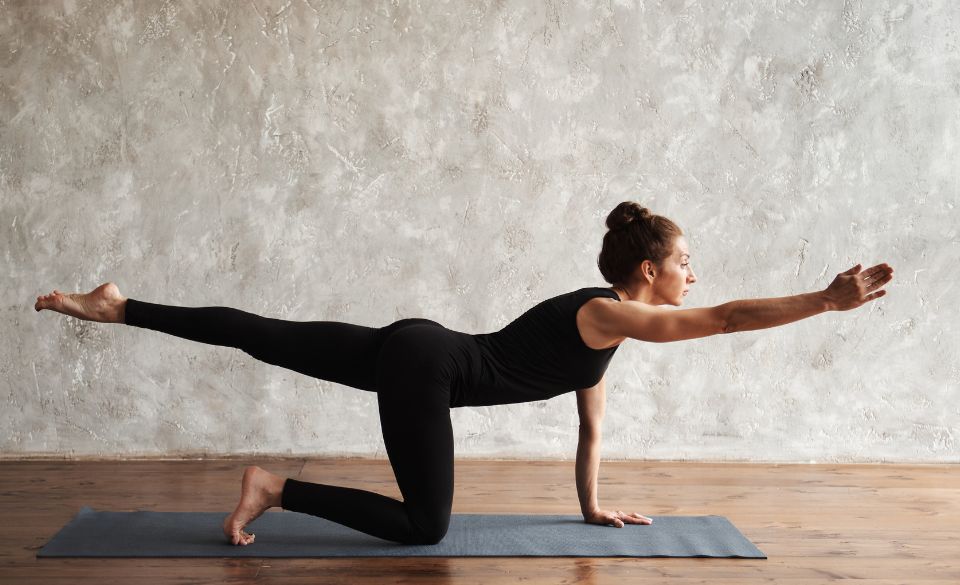
Top 7 Yoga Poses For Runners
Page Contents
- 1. Downward Facing Dog (Adho Mukha Svanasana)
- 2. Triangle Pose (Trikonasana)
- 3. Pigeon Pose (Eka Pada Rajakapotasana)
- 4. Bridge Pose (Setu Bandhasana)
- 5. Warrior II (Virabhadrasana II)
- 6. Standing Forward Fold (Uttanasana)
- 7. Seated Spinal Twist (Ardha Matsyendrasana)
- Finding Balance Through Yoga and Running
- How to Incorporate Yoga into Your Running Routine
- Conclusion
As a runner, you know that hitting the pavement or trails can take a toll on your body. The repetitive impact and stress on your muscles can lead to tightness, imbalances, and even injuries. That’s where yoga comes to the rescue! Incorporating yoga into your running routine can be a game-changer, helping you improve flexibility, balance, and overall performance. In this blog post, we’ll explore the top seven yoga poses that every runner should add to their training to stay strong, flexible, and injury-free.
1. Downward Facing Dog (Adho Mukha Svanasana)
Downward Facing Dog is a classic yoga pose that targets multiple muscle groups in the body, making it an excellent choice for runners. It stretches the calves, hamstrings, and Achilles tendons while also engaging the core and strengthening the shoulders and arms.
To perform Downward Facing Dog, start in a plank position with your hands shoulder-width apart and your feet hip-width apart. Press your hips up and back, creating an inverted V shape with your body. Keep your arms straight, spread your fingers wide, and press your heels toward the ground. Take deep breaths and hold the pose for 30 seconds to 1 minute.
2. Triangle Pose (Trikonasana)
Triangle Pose is fantastic for opening up the hips and stretching the hamstrings and outer thighs. It also helps improve balance and posture, which are essential for maintaining proper running form.
To practice Triangle Pose, stand with your feet wide apart, about 3 to 4 feet. Turn your right foot out to 90 degrees and align your heels. Extend your arms out to the sides at shoulder height. Hinge at your right hip and reach your right hand toward your right ankle or shin, while extending your left arm toward the ceiling. Keep your chest open and gaze up at your left hand. Hold the pose for 30 seconds to 1 minute on each side.
3. Pigeon Pose (Eka Pada Rajakapotasana)
Pigeon Pose is a fantastic hip opener that targets the hip flexors and glutes. It’s particularly beneficial for runners who may experience tightness in these areas due to the repetitive motion of running.
To perform Pigeon Pose, start in a tabletop position, then bring your right knee forward and place it behind your right wrist. Extend your left leg straight back behind you, keeping your hips squared. Slowly lower your upper body down toward the ground, resting on your forearms or forehead. Hold the pose for 30 seconds to 1 minute on each side.
4. Bridge Pose (Setu Bandhasana)
Bridge Pose is an excellent pose for stretching the front of the body, including the hip flexors, quadriceps, and chest. It also helps strengthen the glutes and lower back muscles, which can support your running performance.
To practice Bridge Pose, lie on your back with your feet hip-width apart and your knees bent. Place your arms alongside your body, palms facing down. Press into your feet and lift your hips toward the ceiling, engaging your glutes and core. Keep your thighs parallel to each other and avoid squeezing your buttocks. Hold the pose for 30 seconds to 1 minute.
5. Warrior II (Virabhadrasana II)
Warrior II is a powerful pose that targets the legs, hips, and shoulders. It helps improve lower body strength and stability, which is crucial for maintaining a strong and efficient running stride.
To perform Warrior II, stand with your feet wide apart, about 4 to 5 feet. Turn your right foot out to 90 degrees and bend your right knee, keeping it directly over your right ankle. Extend your arms out to the sides at shoulder height, with your palms facing down. Gaze over your right fingertips and sink deeper into the pose. Hold Warrior II for 30 seconds to 1 minute on each side.
6. Standing Forward Fold (Uttanasana)
Standing Forward Fold is an excellent pose for stretching the hamstrings, calves, and lower back. It also helps calm the mind and promote relaxation, making it a perfect pose to practice after a long run.
To practice Standing Forward Fold, stand with your feet hip-width apart and fold forward from your hips. Keep your knees slightly bent to protect your hamstrings. Let your upper body hang over your legs and relax your neck and shoulders. Hold the pose for 30 seconds to 1 minute, breathing deeply and releasing any tension in your body.
7. Seated Spinal Twist (Ardha Matsyendrasana)
Seated Spinal Twist is a wonderful pose for releasing tension in the spine and stretching the back, hips, and shoulders. It also aids in improving spinal mobility and digestion.
To perform Seated Spinal Twist, sit with your legs extended in front of you. Bend your right knee and place your right foot outside your left knee. Keep your left leg extended or bend it, placing the left foot next to your right hip. Inhale to lengthen your spine, then exhale and twist your torso to the right, placing your left hand on the ground behind you and your right arm on your right knee. Gaze over your right shoulder. Hold the pose for 30 seconds to 1 minute on each side.
Finding Balance Through Yoga and Running
As you continue to incorporate yoga into your running routine, you’ll likely discover the profound impact it has on your overall well-being. Beyond the physical benefits, yoga offers a sense of balance that complements the more rigorous and demanding nature of running. Here are some additional insights to help you find balance through the harmonious practice of yoga and running:
1. Cultivate Mindfulness in Your Runs
Yoga teaches us to be present and mindful in each moment. As you run, bring this awareness into your training. Pay attention to your breath, your form, and the sensations in your body. Mindful running can enhance your focus and enjoyment during your workouts, helping you become more attuned to your body’s needs.
2. Embrace Rest and Recovery
Yoga’s emphasis on rest and recovery is a valuable lesson for runners. Just as savasana (corpse pose) at the end of a yoga practice allows your body to integrate the benefits of the practice, adequate rest after intense running sessions is essential for optimal recovery. Embrace rest days and give your body the time it needs to rejuvenate and repair.
3. Listen to Your Intuition
In both yoga and running, it’s crucial to listen to your intuition and honor what your body is telling you. Yoga encourages us to respect our limits and avoid pushing ourselves into discomfort or injury. Apply this same principle to your running, knowing when to ease up or take a break to prevent overtraining and burnout.
4. Find Joy in Movement
Both yoga and running offer opportunities to find joy in movement. Embrace the sense of freedom and connection with your body as you flow through yoga poses or glide along the trails. Let go of performance pressure at times and simply enjoy the act of moving your body in a way that brings you happiness.
5. Celebrate Progress, Not Perfection
In both yoga and running, progress is a journey rather than a destination. Instead of striving for perfection, celebrate the small victories and improvements along the way. Recognize that both practices are about growth and self-discovery, and each step forward is worth celebrating.
6. Use Yoga for Injury Prevention
Yoga’s focus on flexibility, strength, and balance can be instrumental in preventing running-related injuries. By regularly incorporating yoga poses into your routine, you can address tight areas and imbalances, reducing the risk of common running injuries.
7. Stay Open to Exploration
Just as there are numerous styles of yoga, there are also various types of running experiences. Stay open to exploring different terrains, distances, and race formats. Allow yourself to step outside your comfort zone and embrace the adventure that both yoga and running can offer.
How to Incorporate Yoga into Your Running Routine
Now that you know the top seven yoga poses for runners, the next step is to incorporate them into your running routine effectively. Finding the right balance between running and yoga can be a game-changer in enhancing your performance and overall well-being. Here are some practical tips to help you seamlessly blend yoga into your training:
1. Warm-Up with Yoga
Start your running sessions with a short yoga warm-up to prepare your body for the workout ahead. A dynamic flow that includes movements like Sun Salutations can help loosen up your muscles, increase blood flow, and improve flexibility before hitting the road or trail.
2. Post-Run Cool Down
After a run, take a few minutes for a gentle yoga cool down to stretch and relax your muscles. The top seven yoga poses for runners mentioned earlier are perfect for this purpose. Focusing on your breath during this cool down will also aid in reducing post-run tension and promoting recovery.
3. Cross-Training Days
On days when you’re not running or doing intense workouts, consider dedicating more time to a full yoga practice. A longer yoga session can help you target specific areas of tightness and imbalances, providing your body with the recovery it needs to perform at its best during your next run.
4. Listen to Your Body
Yoga is a highly adaptable practice, so listen to your body’s needs and modify your practice accordingly. If you’re feeling fatigued or have a particularly challenging run scheduled, opt for a gentle and restorative yoga session. On days when you’re full of energy and enthusiasm, go for a more vigorous flow.
5. Join a Yoga Class
If you’re new to yoga or looking to deepen your practice, consider joining a yoga class or workshop. Practicing with a knowledgeable instructor can provide valuable guidance on alignment, proper breathing techniques, and how to tailor yoga poses to suit your individual needs as a runner.
6. Use Yoga Props
Yoga props, such as blocks, straps, and bolsters, can be valuable tools in enhancing your yoga practice. Props can help you access deeper stretches, maintain proper alignment, and make challenging poses more accessible. Incorporating props into your yoga routine can be especially helpful if you’re dealing with any existing injuries or limitations.
7. Embrace the Mind-Body Connection
Yoga is not only about physical postures but also about cultivating mindfulness and the mind-body connection. As you practice yoga, pay attention to your breath and be present in the moment. This awareness can carry over to your running, helping you stay focused and in tune with your body during your training.
Conclusion
Yoga and running are a perfect match, each complementing the other to create a more well-rounded and balanced fitness routine. By incorporating the top seven yoga poses for runners into your training and embracing the mind-body connection that yoga offers, you’ll discover a new level of strength, flexibility, and mental clarity that can propel your running performance to new heights.
Remember, consistency is key. Even a few minutes of yoga each day can make a difference in how you feel and perform as a runner. So, roll out your mat, lace up your running shoes, and embrace the union of yoga and running for a healthier, happier, and more fulfilling running journey.



